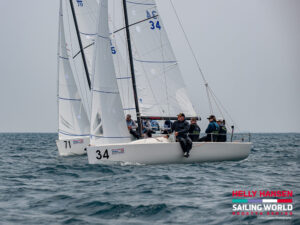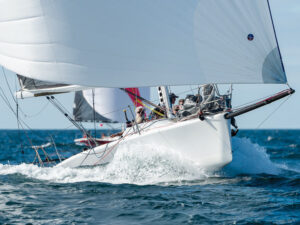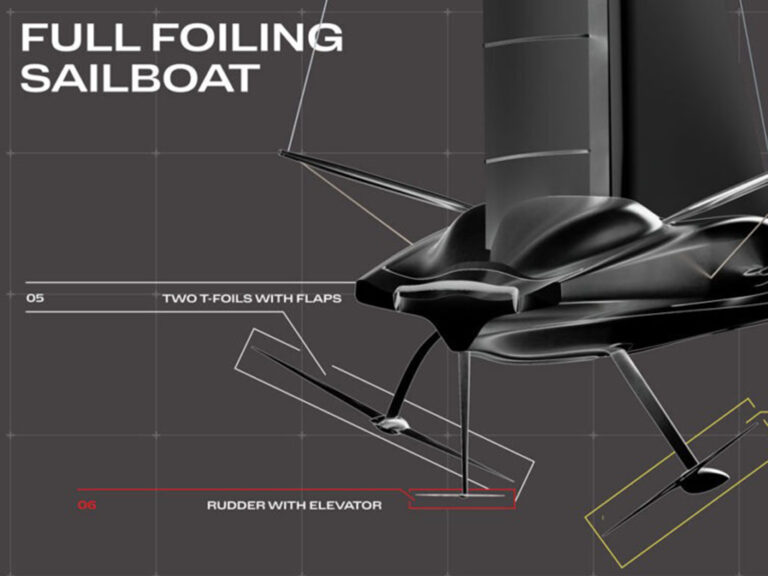
Don’t you hate it when you round the weather mark in the top group and immediately lose distance and positions to crews that jibe right away? There you are, dread in your eyes, watching your lead slip away. It’s worse when you’re the one who jibes away, only to witness the rest of the fleet leaving you in their wake. “Why did we just do that?” you ask. Whenever you find yourself in either of these situations, it’s usually because you have only a vague plan about what you want to do, and it doesn’t pan out. You must have a strategy for exiting the weather mark, one that’s based on your positioning, keeping your air clear, and avoiding traffic.
One of the first things you should ask yourself is whether the beat is skewed. If the wind speed is constant and you’ve spent the majority of the weather leg on one tack, your downwind leg will reflect the same disparity of time on either jibe. In other words, if you’ve spent a lot of time on starboard tack while sailing upwind-because the breeze is shifting to the right, for example-you’ll be spending a lot of time on port tack downwind. By jibing to port early in the run, you position yourself on the “long tack” to the leeward mark. This is the headed tack relative to the course geometry-remember that you want to sail the headed tack downwind. Jibing to port right away will position you directly upwind of the leeward mark sooner, allowing you to take advantage of any shifts from a dead upwind position rather than from an edge. I generally point this out to the rest of the crew near the top of the beat and then keep my eyes open for any late shift.
Next, determine if there’s more wind on one side of the course. This determination comes from observations that you make during the upwind leg and before the start. The side with more pressure will generally be your top priority if all other factors are constant. It’s beneficial to get to more breeze, but the question is, “How do I get there without sacrificing position?” Generally, it’s best to be the weather-most boat when there’s more breeze on one side of the racecourse. You get to the breeze first and can sail a lower course than boats that either jibe later or sail away from the wind. It’s critical to identify whether or not there’s more breeze on one side or the other. For example, make sure the pressure you felt on the right while going up the beat wasn’t just a random puff or a filling breeze that has since covered the entire course.
Don’t forget about current when sailing downwind; it’s important because it skews the run. If the current is going perpendicular to a course that’s square to the wind it’s important to get to the upcurrent side (the side from which the current is flowing) because that will be the longer jibe. Positioning your boat upcurrent also allows you more freedom to play the shifts farther down the leg. If you sail downcurrent initially, you’ll spend the rest of the leg trying to get back to the center of the course in order to take advantage of shifts. The lighter the wind, the more important it is to be upcurrent because you’re going slower through the water and the vector aiming toward the mark gets skewed in the direction of the current.
Whether due to a windshift, tidal effect, or better wind to one side, make the rest of the crew aware which side is the favored before you round the weather mark so they can be ready to do whatever it takes to get there.

Most classes sail windward-leeward courses nowadays, making an escape from the weather mark more difficult. If there’s an offset mark, there’s usually a zone of dead air under the offset leg. This zone of bad air extends about 10 lengths to leeward of the offset leg and you should cross it only if the benefits of getting to a particular side are huge. To prepare for getting to the other side of the dead zone it’s a good idea to sail artificially low (below VMG angles) to get as close to the zone as possible without having to sail in it. After 10 lengths you should be able to jibe to the side you want with minimal loss. Ideally, you’ll be poked away from boats that didn’t jibe-though they may have moved forward some-plus you’ll have the favored side and will have sailed away from boats that jibed into the zone.
If you need to jibe right away, don’t forget about the starboard-tack parade and the ghastly amount of bad air behind it. When sailing upwind you can get a small lift off the leech of an upwind boat when crossing behind, and the same happens downwind. Basically, the wind is bent about 10 degrees by the sails of an upwind boat, so when you’re sailing to leeward of a line of upwind boats you’re actually sailing in a 10-degree lift in disturbed air. This isn’t something you’d do on the open water, so it shouldn’t be something you would do after rounding a mark unless the side of the course you’re sailing to is favored dramatically.
Given this background, consider the following scenario: You’re halfway up the beat of a leg that takes you towards the lee side of an island and the breeze suddenly goes left 10 degrees. With the breeze left, it’s affected by the island, and it’s lighter. The current is flowing from right to left. The majority of the fleet has gone right and there’s a stack up of starboard tackers on the layline in more breeze but headed. You come in from the left and round the mark first.
Based on the shift you came into the mark with, you would extend on starboard downwind. This gets you clear of the parade of boats on starboard tack, away from the offset leg’s bad air, and it keeps you on the long tack. However, you’re now going downcurrent in light air. And you’re sailing toward the island away from the best breeze. What would your call be if you were the tactician?
If there are no boats around you and you can sail deeper than normal, this is your best escape. As you sail away from the island your breeze should increase, and you’ll slowly be able sail your optimum angle-plus you’re on the headed tack. At this point, disregard the current, unless you think the breeze is going to shut down completely, in which case you want to get upcurrent right away. Your most important goal is more wind and getting away from the traffic at the mark. This sets you up on the long tack, and when the wind goes back to its original direction, you can jibe.
If you’re in a lot of traffic, concentrate on sailing a slightly lower course than the group around you. Don’t be afraid of the pack climbing up, because when they get to the point that they’ll affect you, you can jibe away. You should be past the 10-length dead zone and headed toward more breeze. Doing this gives you the option of checking in on the other side of the course, and if it looks bad-try to figure this out in the first two minutes-you can jibe back to maintain contact with the pack. In an ideal world you’re farther from the island so you have a little more breeze so you don’t lose too much from the two jibes. When the wind shifts back, you’ll be on the inside with starboard advantage if you have to jibe again.
There are all kinds of options based on what the wind is doing and how the fleet is positioned. As in standard downwind sailing, at least try to sail in the most breeze on the headed tack. Figure this out before you get to the weather mark so the crew knows, and stick to your game plan.
For more about downwind tactics, check out “A Low-Risk Run,” the latest installment in our Around the Racecourse series.









